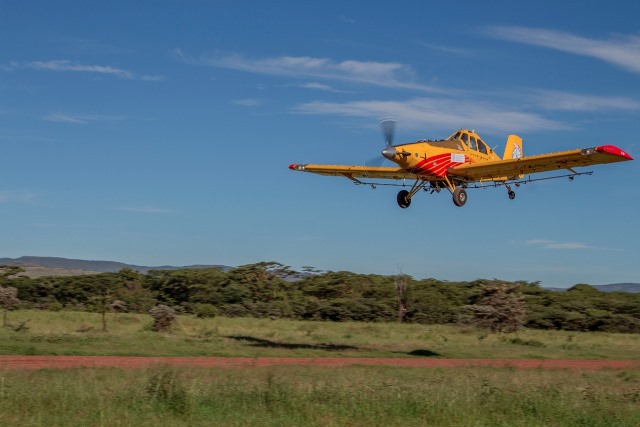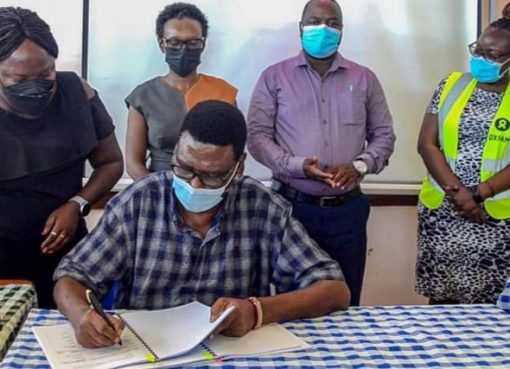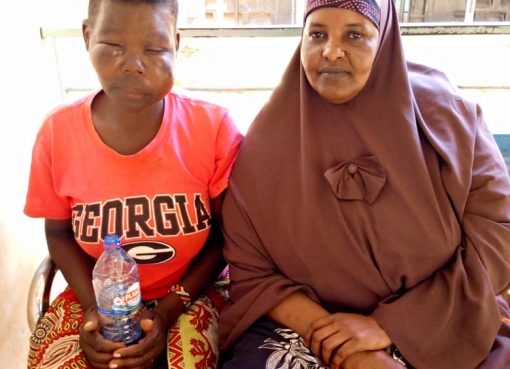The Government has drastically contained the swarms of locusts that invaded the country recently in the wake of the ongoing Covid 19 pandemic and the floods related havoc.
Agriculture, Livestock and fisheries Principal Secretary Hamadi Boga says that despite the two major challenges reports have show that the number of locusts are reducing and that at one time Samburu County had over 400 swarms at its peak but was lately reporting less than three and six swarms.

“This is an indication that we are flattening the curve and together with the Food and Agriculture Authority (FAO) we are working on a strategy to engage local and international experts such as Tegemeo Institute to assess the damage so far caused by locusts in the 27 Counties affected.
FAO, World Bank and counties, the PS says the had mobilized adequate resources to fight the pests and so far there was at least 90,000 litres of pesticide that can effective cover close to 200,000 hectares since half a litre was enough to spray one hectare.
Prof Boga who was speaking during a desert locust media field visit in Isiolo last week explained that so far the Government and other organizations under the strategy employed to contain the locusts has mobilized Ksh2.4 billion noting that government has contributed Ksh39 million, African Development Bank (AfDB) Ksh 500 million and World Bank Ksh1.4 billion.
The cash is being extended to financing chemicals procurement and maintaining six spraying aircrafts, vehicles and personnel among other equipment’s being used for the same.
The partners, Prof. Boga noted have so far have deployed six spraying aircrafts –two from Kenya Army, three from FAO and one from Desert Locust Control Organization (DLCO) to deal with Counties where the pests are heavily concentrated namely Isiolo, Marsabit, Turkana, Samburu and some locations of Laikipia.
“We are also facing the challenge of the current weather as most of the areas are experiencing heavy rains making it difficult for spraying aircrafts and ground teams over and above vast the terrains,” he added.
Further Prof. Hamadi stated the activity is also facing the challenge of delayed procurement of the chemicals as some countries such as Japan where the chemicals are being sourced are also facing the challenge of spread of the Covid-19.
Albert Lemasulani a resident and community leader in Isiolo County said the locusts have eaten their vegetation and hatching eggs thus affecting their livestock with some dying and prompting pastoralists to start migrating to other areas
“There is also a likelihood of new locust generation being produced if they are not contained in good time since old locusts have left eggs.
The pests Lemasulani said had consumed their crop leaving many farmers destitute especially now that the local livestock markets which could offer alternative source of livelihoods were shut due to Covid 19 pandemic.
He most farmers had lost their purchasing power and may soon rely on government relief before they regain their base to fend for themselves.

Tiampati Leleti a resident and village leader in Samburu County also said since March this year pastoralists in the area had lost pasture after the invasive insects swept the entire vegetation.
“We fear that if the invasion of locust continues, we are likely to suffer irreparable loses economically and socially. Our livestock are emaciated and suffering from retarded growth because they do not feed well due to lack of enough pasture ” Tiampati added.
Isiolo County Governor Mohamed Kuti said that since December when the locusts invasion was reported in the region from Yemen through Ethiopia and Somalia meaningful progress has been achieved.
He noted that the number of swarms that was initially being witnessed in December and January has reduced substantially.
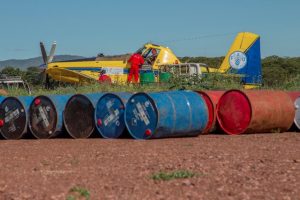
“The fight against the migratory pests has created an opportunity for the unemployed youth in the region. We have engaged youth who are assisting us to trace the whereabouts of the locust and thus enable us to actively fight the pests”, he said .
Governor Kuti further said that Technology coupled with intensive surveillance has served us well with the youth now being trained and are able to relay information to the control centre that is located at Lewa wildlife conservancy.
Assistant FAO Representative (Programmes), Hamisi Williams said in order for the fight against locusts to be sustained, both on the ground and by air spraying, they had trained and deployed youth to trace the location of the locusts.
He said the exercise also entailed the equipping of two trained masters in every county to impart the skills to new recruits to also train other people in their localities.
“In Garissa county 25 youth have been trained, 50 in Mandera, 90 in Isiolo to serve in Laikipia and Baringo counties and a further 75 youth are undergoing training in Samburu County and more in Turkana”, he said
The youth, Hamisi explained were equipped with smart phones complete with an application e-locust and had established six operation bases at Kilimo house, Isiolo, Garissa, Wajir, Lodwar and Marsabit to coordinate the exercise.
He said the bases were the collection point for data collected from the field operations before they were later shared with both locally and international recipients including the FAO headquarters in Rome, Italy.
FAO has put in place a locust control centre at the Lewa Conservancy to convey data that is being collected from the locust infested areas and all the ground teams have been trained to use the E-locust 3M app.
Heath McRae , a desert locust specialist in charge of the locust control centre in Lewa says they have been using an e-locust system to collect data from the ground team and convey it to the aerial spray team to know the exact areas to target.
“It’s an easy app to use. One is required to go to the e-locust 3M platform, log in and provide information. Once you tap send, that info is picked at 51D in Lewa and same information is picked at the information centre in Kilimo House,” said McRae.
The technology that is being used by FAO to track the pests has seen them collaborate with an organization known as Plant Village and together with counties engaged 900 youth by facilitating them with motor bikes to help in identifying and report about the whereabouts of the locusts.
Hamisi explained that that the locust invasion is the worst the region has experienced for the last 70 years saying initially when locusts were reported in the region, national government and counties were not well prepared thus led to spread of the migratory pests.
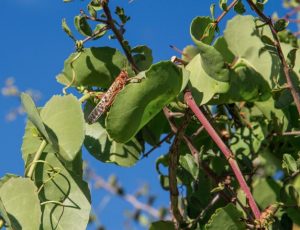
AS FAO, Hamisi said that they were in the process of adding more aircrafts and also procure other sophisticated gadgets to help in identifying the locust.
“Initially spraying is being carried out in all the areas but going forward spraying will only be done where the swarms are located. In security prone areas like Suguta and Baragoi, we are collaborating with local communities as well as security authorities to make the exercise fruitful”, he said
Hamisi noted that they expect that in the next one and half month, locust swarms will subside a situation being dictated by winds. “Currently winds are blowing from east and south, a situation likely to move the swarms to the neighbouring countries like Sudan and Uganda.”.
Tyson Lengoros a youth under the plant village group said “I graduated from Mt. Kenya University last December. I and other youth were engaged by FAO to help in tracing the locusts. I have been facilitated to track the locusts through surveillance. We are enabled through motorbikes and we work from our own areas. Once we trace the locust swarms, we report to the disaster management unit base at Isiolo County”.
Since the invasions of locusts in December last year, the government has been doing everything to ensure the Desert Locusts do not escalate to a plague level. The normal breeding season for Desert Locusts is from January to March. FAO, together with the government of Kenya, has put together a six-month action plan, while monitoring the situation
By Wangari Ndirangu


